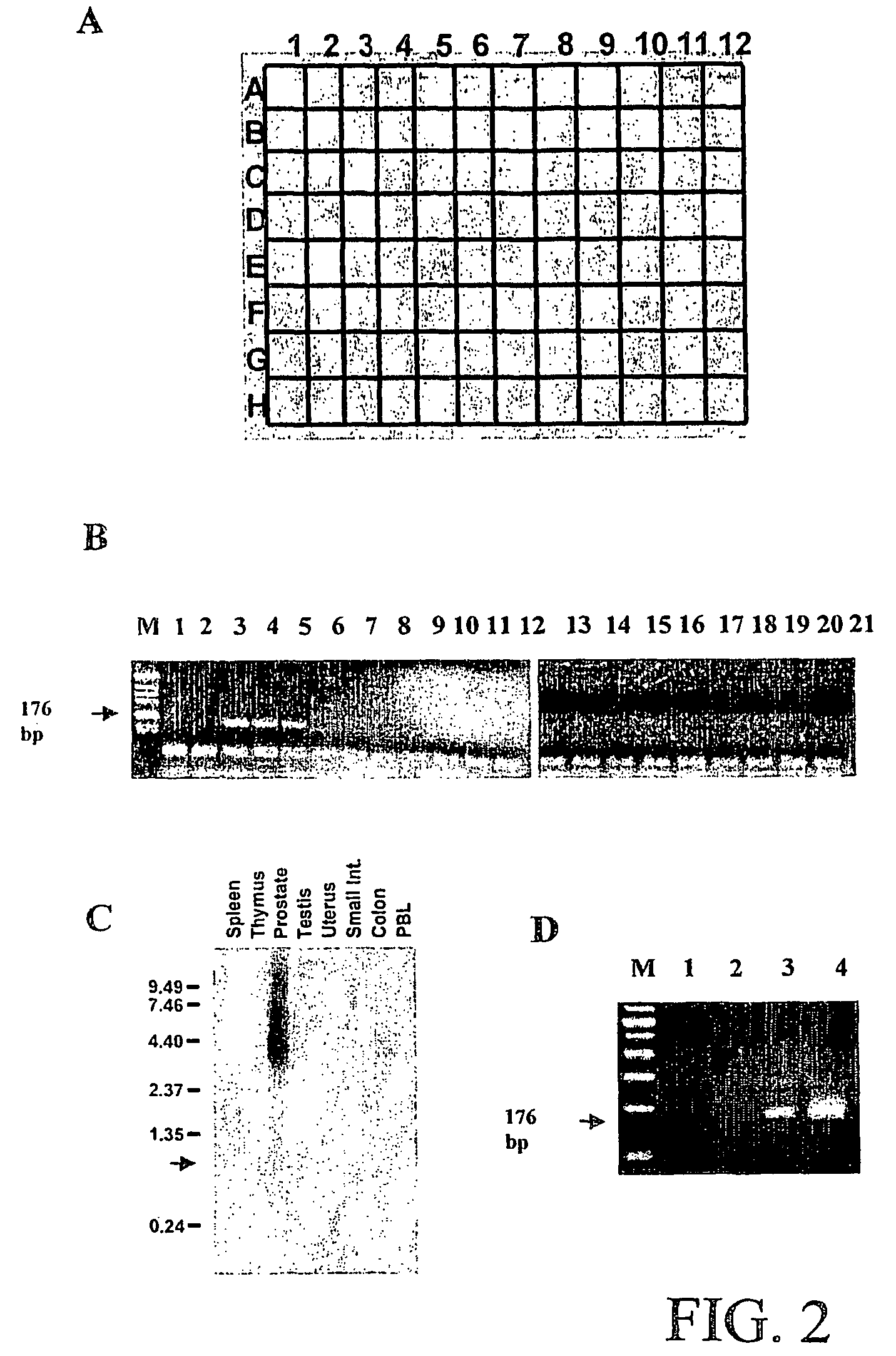Gene expressed in prostate cancer and methods of use
a gene and prostate cancer technology, applied in the prostate field, can solve problems such as early diagnosis and problems
- Summary
- Abstract
- Description
- Claims
- Application Information
AI Technical Summary
Problems solved by technology
Method used
Image
Examples
example 1
Computer Analysis of EST Sequences
[0156]The NCBI dbEST / CGAP database (see Emmert-Buck et al., Science 274:998, 1996; Krizman, D. B. et al., Cancer Res. 56:5380, 1996); Strausberg, R. L. et al., Nat. Genet. 16:415, 1997), was used as a source for cDNA sequences. The ESTs from human tissues and tumors were downloaded from the NCBI EST database. The cDNA libraries that we processed are listed in several websites, including the Unigene Cluster from the NCBI website, amongst others. The EST sequences were clustered and sorted as described before (Vasmatzis, G. et al., Proc. Natl. Acad. Sci., USA 95:300, 1998). However, the candidate gene list was updated by using the EST dataset of, May 2000. Two updated candidate lists were prepared, one with the specificity cutoff for prostate of three as before and another with the cutoff value of six.
[0157]The cluster CW-1 is identified by computer analysis of the human EST database as a prostate specific cluster. There are 5 ESTs in this cluster of ...
example 2
Specificity of CW-1 Cluster
[0158]To determine the tissue specificity of the CW-1 cluster experimentally, a multi-tissue dot blot analysis was performed using a PCR generated DNA fragment from the cluster as a probe.
[0159]The human multiple tissue RNA blot (RNA Masterblot, Clontech, Palo Alto, Calif.) and Northern blot (Multiple Tissue Northern blot, Human II, Clontech) hybridizations were carried out as described previously (Liu et al., Biochem. Biophys. Res. Commun., 264:833, 1999). Briefly, RNA hybridizations with multiple tissue RNA dot-blot and northern blot were performed as follows: membranes were pre-hybridized for 2 h in hybridization solution (Hybrisol I; Intergen, Purchase, N.Y.) at 45° C.
[0160]The cDNA probe was produced from a PCR fragment generated using the primer pair CW74: (SEQ ID NO: 3, AAG CTA GAC AGG CAG CAG GAC A) and CW75 (SEQ ID NO:4, CATGAG AGA GCT GAG TGT GCA G; CW91: SEQ ID NO: 5, GCC TGA TCT GCT CTG GGA CTC TGG), and was labeled with 32P by random primer ex...
example 3
Full Length cDNA Cloning of CW-1
[0163]To determine the transcript size of the CW-1 cluster in tissues, an analysis was made of a Northern blot containing mRNAs from different tissues including prostate. The PCR generated probe that was used for the dot blot analysis was also used in this experiment. Methods are described in Example 2.
[0164]As shown in FIG. 2C, several bands of different sizes are detected only in prostate lane. The smallest band, which likely is the mature mRNA, is about 900 base pairs (bp) in size (arrow). The high molecular weight bands which are detected by the probe are probably unspliced variants of the transcript or transcripts with longer 3′ untranslated regions.
[0165]To isolate the full-length cDNA for CW-1 a 5′ and 3′ RACE PCR method was employed to isolate a clone of 917 bp in size (see FIG. 6).
[0166]The primers used in this study were synthesized by Lofstrand Lab, (Gaithersburg, Md.) and the nucleotide sequences of the primers are as follows: Ngepex25, AC...
PUM
| Property | Measurement | Unit |
|---|---|---|
| dissociation constant | aaaaa | aaaaa |
| dissociation constant | aaaaa | aaaaa |
| dissociation constant | aaaaa | aaaaa |
Abstract
Description
Claims
Application Information
 Login to view more
Login to view more - R&D Engineer
- R&D Manager
- IP Professional
- Industry Leading Data Capabilities
- Powerful AI technology
- Patent DNA Extraction
Browse by: Latest US Patents, China's latest patents, Technical Efficacy Thesaurus, Application Domain, Technology Topic.
© 2024 PatSnap. All rights reserved.Legal|Privacy policy|Modern Slavery Act Transparency Statement|Sitemap



